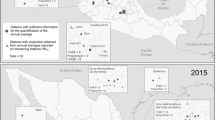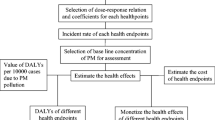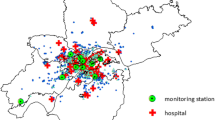Abstract
The concentrations of particulate matter with aerodynamic diameters less than 2.5 µm (PM2.5) and 10 µm (PM10) is a widespread concern and has been demonstrated for 103 countries. During the past few years, the exposure–response function (ERf) has been widely used to estimate the health effects of air pollution. However, past studies are either based on the cost-of-illness or the willingness-to-pay approach, and therefore, either do not cover intangible costs or costs due to the absence of work. To address this limitation, a hybrid health effect and economic loss model is developed in this study. This novel approach is applied to a sample of environmental and cost data in China. First, the ERf is used to link PM2.5 concentrations to health endpoints of chronic mortality, acute mortality, respiratory hospital admission, cardiovascular hospital admission, outpatient visits—internal medicine, outpatient visits—pediatrics, asthma attack, acute bronchitis, and chronic bronchitis. Second, the health effect of PM2.5 is monetized into the economic loss. The mean economic loss due to PM2.5 was much heavier in the North than the South of China. Furthermore, the empirical results from 76 cities in China show that the health effects and economic losses were over 4.98 million cases and 382.30 billion-yuan in 2014 and decreased dramatically compared with those in 2013.


Similar content being viewed by others
References
Alberini, A., Cropper, M., Fu, T.T., Krupnick, A., Liu, J.T., Shaw, D., et al.: Valuing health effects of air pollution in developing countries: the case of Taiwan. J. Environ. Econ. Manag. 34(2), 107–126 (1997)
BP Group World Energy Statistics Yearbook, 2016. https://www.bp.com/zh_cn/china/reports-and-publications/_bp_2017-_.html (2017). Accessed 16 Dec 2016
Briggs, A., Sculpher, M., Buxton, M.: Uncertainty in the economic evaluation of health care technologies: the role of sensitivity analysis. Health Econ. 3:95–104 (1994)
Clean Air Alliance of China. 12th Five-year plan on prevention and control of air pollution in key regions. http://en.cleanairchina.org/product/6285.html (2012)
Cohen, A.J., Ross, A.H.B., Pandey, K.D., Krzyzanowski, M., Kunzli, N., Gutschmidt, K., et al.: The global burden of disease due to outdoor air pollution. J. Toxicol. Environ. Health 68(13–14), 1301–1307 (2005)
Carugno, M., Consonni, D., Randi, G., Catelan, D., Grisotto, L., Bertazzi, P.A., et al.: Air pollution exposure, cause-specific deaths, and hospitalizations in a highly polluted Italian region. Environ. Res. 147, 415–424 (2016)
Dockery, D.W., Rd, P.C., Xu, X., et al.: An association between air pollution and mortality in six U.S. cities. N. Engl. J. Med. 329(24), 1753–1759 (1993)
Evans, M.F., Poulos, C., Smith, V.K.: Who counts in evaluating the effects of air pollution policies on households? Non-market valuation in the presence of dependencies. J. Environ. Econ. Manag. 62(1), 65–79 (2011)
Guo, Y., Zeng, H., Zheng, R., Li, S., Barnett, A.G., Zhang, S., et al., 2016. The association between lung cancer incidence and ambient air pollution in China: a spatiotemporal analysis. Environ. Res. 144(Pt A), 60–65
Gao, T., Guo, X.L.I., Mei, X.U., Wang, X.Y., Liang, F.C., Zeng, Q., et al.: Health economic loss evaluation of ambient PM2.5 pollution based on willingness to pay. J. Environ. Health 8, 697–700 (2015)
Hammitt, J., Zhou, Y.: The economic value of air-pollution-related health risks in china: a contingent valuation study. Environ. Resour. Econ. 33, 399–423 (2006)
He, G., Fan, M., Zhou, M.: The effect of air pollution on mortality in China: evidence from the 2008 Beijing Olympic Games. J. Environ. Econ. Manag. 79, 18–39 (2016)
Hoffmann, S., Qin, P., Krupnick, A., et al.: The willingness to pay for mortality risk reductions in Mongolia. Resour. Energy Econ. 34, 493–513 (2012)
Huang, D.S., Zhang, S.Q.: Health benefit evaluation for PM2.5 pollution control in the Beijing–Tianjin–Hebei region of China. China Environ. Sci. 33(1), 166–174 (2013)
Hao, Y., Liu, Y.M.: The influential factors of urban PM2.5 concentrations in China: a spatial econometric analysis. J. Clean. Prod. 112, 1443–1453 (2015)
Kan, H., Chen, B.: Analysis of exposure–response relationships of air particulate matter and adverse health outcomes in China. J. Environ. Health 19(06), 422–424 (2002)
Kan, H., Chen, B.: Particulate air pollution in urban areas of Shanghai, China: a health-based economic assessment. Sci. Total Environ. 322(1–3), 71–79 (2004)
Koop, G., Tole, L.: Measuring the health effects of air pollution: to what extent can we really say that people are dying from bad air? J. Environ. Econ. Manag. 47, 30–54 (2004)
Krupnick, A., Cropper, M.: The social costs of chronic heart and lung disease. In: Elgar, E. (ed.) Valuing Environmental Benefits, Selected Essays of Maureen Cropper. Edward Elgar, Cheltenham (2000)
Kunzli, N., Kaiser, R., Medina, S., et al.: Public-health impact of outdoor and traffic-related air pollution: a European assessment. Lancet. 356(9232), 795–801 (2000)
Lu, F., Zhou, L., Xu, Y., Zheng, T., Guo, Y., Wellenius, G.A., et al.: Short-term effects of air pollution on daily mortality and years of life lost in Nanjing, China. Sci. Total Environ. 536, 123–129 (2015)
Lu, X., Teng, Y., Fung, J.C.H., Lin, C.: Estimation of health and economic costs of air pollution over the Pearl River Delta region in China. Sci. Total Environ. 566–567, 134–143 (2016)
Li, W., Xie, Y., Chen, J.: Methods and Applications of Strategic Environmental Assessment in Health Risk Assessment of Residents in Exposure to Ambient Air Pollution. Science Press, Beijing (2016)
Ministry of Environmental Protection. Air pollution prevention and control action plan. http://www.cleanairchina.org/product/6349.html (2013). Accessed 16 Dec 2016
Mu, Q., Zhang, S.: Assessment of historical change of economic losses and health effects due to PM2.5 heavy pollution in 2001–2013 in China. Peking Univ. (Nat. Sci. Ed.) 51(4), 694–706 (2015)
Nam, K.M., Selin, N.E., Reilly, J.M., Paltsev, S.: Measuring welfare loss caused by air pollution in Europe: a CEG analysis. Energy Policy 38(9), 5059–5071 (2010)
National Bureau of Statistics of China. Statistical communique of China on the national economic and social development. http://www.tjcn.org/tjgb/. Accessed 16 Dec 2016
National Bureau of Statistics of the People’s Republic of China, 2014–2015. China city statistical yearbook. http://www.stats.gov.cn/tjsj/ndsj/. Accessed 16 Dec 2016
National Health and Family Planning Commission of China. Health Statistical Yearbook, 2013. http://www.nhfpc.gov.cn/zwgkzt/tjnj/list.shtml. Accessed 16 Dec 2016
National Bureau of Statistics, State Environmental Protection Administration. China statistical yearbook on environment, 2014–2015
Pan, X., Li, G., Gao, T.: Dangerous Breath: Study on the Health Damages and Economic Losses of PM2.5. China Environmental Science Press, Beijing (2012)
Pope, C.A., Burnett, R.T., Thun, M.J., et al.: Lung cancer, cardiopulmonary mortality, and long-term exposure to fine particulate air pollution. J. Am. Med. Assoc. 287(9), 1132–1141 (2002)
Rui, W., Dai, H., Yong, G., Yang, X., Masui, T., Liu, Z., et al.: Economic impacts from PM2.5 pollution-related health effects: a case study in Shanghai. Environ. Sci. Technol. 51(9), 5035–5042 (2017)
State Environmental Protection Administration of China. Report on the state of the environment in China. http://www.zhb.gov.cn/hjzl/zghjzkgb/lnzghjzkgb/ (2014). Accessed 16 Dec 2016
Sueyoshi, T., Yuan, Y.: China’s regional sustainability and diversified resource allocation: DEA environmental assessment on economic development and air pollution. Energy Econ. 49, 239–256 (2015)
Sun, J., Zhong, Y.: Economic analysis of the factors influencing PM2.5 in China’s Metropolises: an empirical Study based on city-level panel data. Ecol. Econ. 31(3), 62–65 (2015)
Tam, W.W.S., Wong, T.W., Wong, A.H.S.: Association between air pollution and daily mortality and hospital admission due to ischaemic heart diseases in Hong Kong. Atmos. Environ. 120, 360–368 (2015)
Tang, D., Wang, C., Nie, J., Chen, R., Qiao, N., Kan, H., et al.: Health benefits of improving air quality in Taiyuan, China. Environ. Int. 73C(4), 235–242 (2014)
Viscusi, W.K., Magat, W.A., Huber, J.: Pricing environmental health risks: survey assessments of risk-risk and risk-dollar trade-offs for chronic bronchitis. J. Environ. Econ. Manag. 21(1), 32–51 (1991)
Voorhees, A.S., Wang, J., Wang, C., Zhao, B., Wang, S., Kan, H.: Public health benefits of reducing air pollution in Shanghai: a proof-of-concept methodology with application to BenMap. Sci. Total Environ. 485–486(1), 396–405 (2014)
Wang, H., Mullahy, J.: Willingness to pay for reducing fatal risk by improving air quality: a contingent valuation study in Chongqing, China. Sci. Total Environ. 367, 50–57 (2006)
Wang, J., Wang, S., Voorhees, A., et al.: Assessment of short-term PM2.5-related mortality due to different emission sources in the Yangtze River Delta, China. Atmos. Environ. 123, 440–448 (2015)
Wang, P., Mu, H.: Economic assessment on health loss of particulate air pollution in Dalian of China. In: Bioinformatics and Biomedical Engineering (iCBBE), 2010 4th International Conference on IEEE. pp. 1–4 (2010)
Wei, W.X., Luo, Q.H.: An empirical analysis of residents’ willingness to pay and their behaviors in PM2.5 governance in the Beijing–Tianjin–Hebei region. Stat. Res. 34(3), 55–64 (2017)
Wang, S., Zhou, C., Wang, Z., Feng, K., Hubacek, K.: The characteristics and drivers of fine particulate matter (PM2.5) distribution in China. J. Clean. Prod. 142, 1800–1809 (2017)
World Bank. Cost of Pollution in China: Economic Estimates of Physical Damages. The World Bank, Washington, DC (2007)
World Health Organization. Ambient Air Pollution: A Global Assessment of Exposure and Burden of Disease. WHO Document Production Services, Geneva (2016)
World Health Organization. WHO’s Urban Ambient Air Pollution database. http://www.who.int/phe/health_topics/outdoorair/databases/cities/en/ (2016). Accessed 16 Dec 2016
Xie, X.: The value of health: assessment of environmental benefits and control strategy of urban air pollution, Doctoral Dissertation, Peking Univeristy (2011)
Xie, P., Liu, X.Y., Liu, Z.R., Tian-Tian, L.I., Bai, Y.H.: Exposure-response functions for health effects of ambient particulate matter pollution applicable to China. China Environ. Sci. 29(10), 1034–1040 (2009)
Zhang, X.: Valuing Mortality Risk Reductions Using the Contingent Valuation Methods: Evidence from A Survey of Beijing Residents in 1999. Centre for Environment and Development, Chinese Academy of Social Sciences, Beijing (2002)
Zhang, M., Song, Y., Cai, X., et al.: Economic assessment of the health effects related to particulate matter pollution in 111 Chinese cities by using the economic burden of disease analysis. J. Environ. Manag. 88, 947–954 (2008)
Zhou, M., He, G., Liu, Y., Yin, P., Li, Y., Kan, H., et al.: The associations between ambient air pollution and adult respiratory mortality in 32 major Chinese cities, 2006–2010. Environ. Res. 137, 278–286 (2015)
Acknowledgements
Our heartfelt thanks should also be given to the National Natural Science Foundation of China (NSFC) (71473180, 71201010, 71303174, 71303076, and 71673083), National Philosophy and Social Science Foundation of China (14AZD068, 15ZDA054,16ZZD049), Guangdong Young Zhujiang Scholar (Yue Jiaoshi [2016]95), Natural Science Foundation for Distinguished Young Talents of Guangdong (2014A030306031), Soft Science Foundation of Guangdong (2014A070703062), Social Science Foundation of Guangdong (GD14XYJ21), Distinguished Young Teachers of Guangdong ([2014]145), High-level Personnel Project of Guangdong ([2013]246), Guangdong key base of humanities and social science—Enterprise Development Research Institute, Institute of Resource, Environment and Sustainable Development Research, and Guangzhou key base of humanities and social science—Centre for Low Carbon Economic Research for funding supports. Dinh-Tri Vo recognizes financial support from University of Economics Ho Chi Minh city, Vienam.
Author information
Authors and Affiliations
Corresponding authors
Ethics declarations
Conflict of interest
There are no conflicts of interest on behalf of all authors, neither ethics violation coming from the funding sources that have been acknowledged (main academic).
Rights and permissions
About this article
Cite this article
Zhu, B., Pang, R., Chevallier, J. et al. Including intangible costs into the cost-of-illness approach: a method refinement illustrated based on the PM2.5 economic burden in China. Eur J Health Econ 20, 501–511 (2019). https://doi.org/10.1007/s10198-018-1012-0
Received:
Accepted:
Published:
Issue Date:
DOI: https://doi.org/10.1007/s10198-018-1012-0
Keywords
- PM2.5
- Exposure–response function
- Cost-of-illness method
- Willingness-to-pay method
- Health effects
- Economic losses




